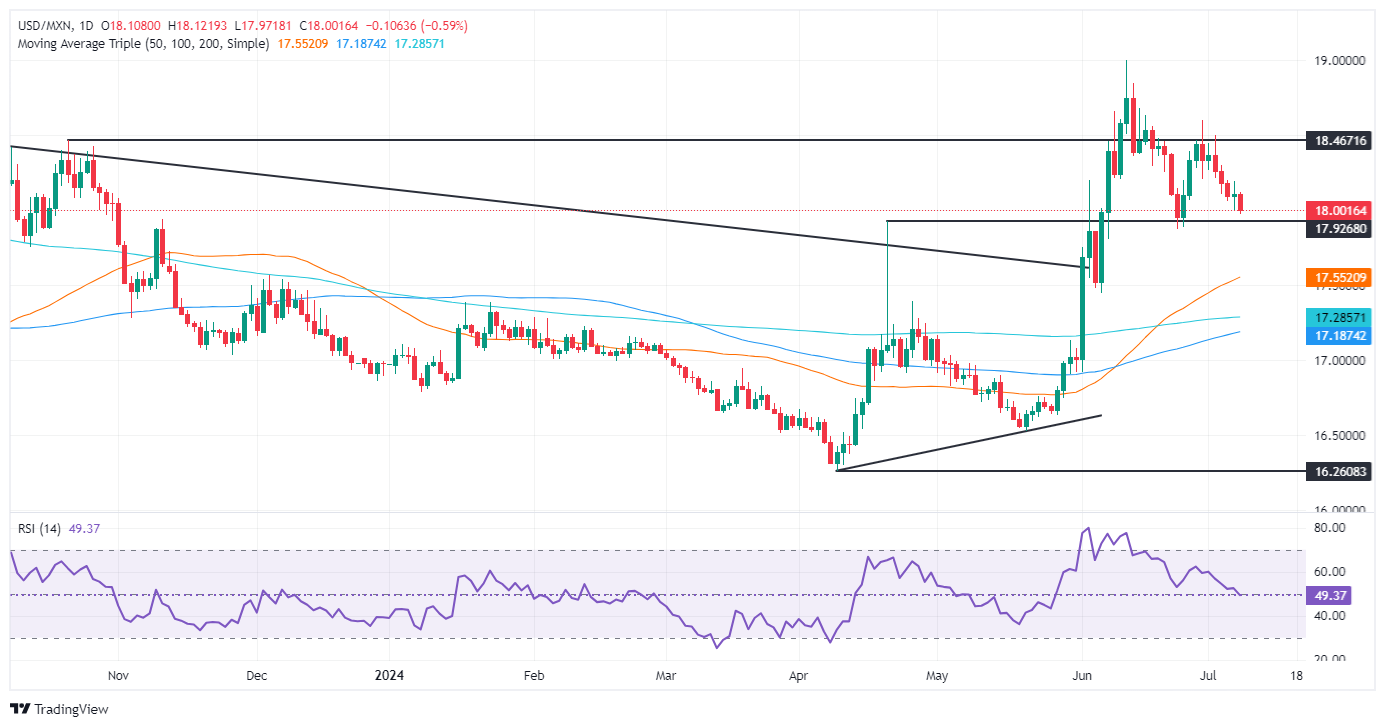- Mexican Peso rallies as USD/MXN drops below 18.00 and hits lowest level since June 25.
- June’s CPI report, Consumer Confidence, and Industrial Production to shape Mexico's economic outlook.
- Banxico minutes likely to signal patience on rate cuts amid steady inflation expectations.
The Mexican Peso rallied sharply against the US Dollar as the USD/MXN fell below the 18.00 psychological figure on Monday, a level last seen on June 25. This signaled that Peso’s buyers remain committed to the so-called “carry trade,” which underpins the Mexican currency. Therefore, the exotic pair exchanged hands at 17.99, down 0.45%.
Mexico’s economic docket will interest traders. The focus is June’s Consumer Price Index (CPI) report, which will be released on July 9. Further data, like Consumer Confidence and Industrial Production, will be released, which will dictate the economic trend and set it to slow down, according to analysts.
On Thursday, the Bank of Mexico (Banxico) will reveal the latest meeting monetary policy minutes, which are expected to show that the central bank will remain patient regarding cutting borrowing costs.
Across the border, the New York Federal Reserve revealed that consumer inflation expectations were lowered from 3.2% to 3% for one year. Besides that, market players will be focused on Federal Reserve (Fed) Chair Jerome Powell's speech at the US Congress on Tuesday and Wednesday and the release of June’s inflation figures.
Last week’s US jobs data sparked speculation that the Fed might ease policy in September, according to the CME FedWatch Tool data. Odds for a September cut stand at 73%, up from 71% last Friday.
Daily digest market movers: Mexican Peso rises further despite firm US Dollar
- Banxico’s survey showed that economists estimate the Gross Domestic Product (GDP) will end the year at 2%, down from 2.1%. They expect Banxico to cut rates from 11.00% to 10.25%, up from 10.00% projected in May.
- Some analysts in Mexico estimate the economy might slow down but dodge a recession, according to the National Statistics Agency (INEGI) Coincident Indicator. Despite that, they said reforms pushed by President Andres Manuel Lopez Obrador (AMLO), particularly the judiciary reform, could affect the country’s creditworthiness.
- Mexico’s CPI is expected to rise from 4.69% YoY to 4.84% in June, while core CPI is estimated to dip from 4.21% to 4.15% annually.
- US CPI is foreseen to drop from 3.3% to 3.1% in the 12 months to June, while underlying inflation is projected to stay firm at 3.4% YoY.
- US Dollar Index (DXY), which tracks the value of a basket of six currencies against the American Dollar, stays firm at 104.94, up 0.06%.
Technical analysis: Mexican Peso stays near weekly highs as USD/MXN hovers around 18.00
The USD/MXN reached a nine-day low of 17.97, though some bids below the 18.00 figure lifted the pair above the latter. The Greenback remains soft against the Peso. The momentum has shifted in the sellers' favor, with the Relative Strength Index (RSI) about to drop below the 50-neutral line.
If USD/MXN achieves a daily close below 18.00, the next support would be the June 24 swing low of 17.87. Further losses lie underneath at the 50-day Simple Moving Average (SMA) at 17.56, followed by the 200-day SMA at 17.26. The next floor level would be the 100-day SMA at 17.17.
For a bullish resumption, the USD/MXN must surpass 18.10, followed by a rally above the June 28 high of 18.59, so buyers can challenge the YTD high at 18.99. Conversely, sellers will need a drop below 18.00, which could extend the pair’s decline toward the December 5 high, which turned support at 17.56, followed by the 50-day Simple Moving Average (SMA) at 17.37.

Banxico FAQs
The Bank of Mexico, also known as Banxico, is the country’s central bank. Its mission is to preserve the value of Mexico’s currency, the Mexican Peso (MXN), and to set the monetary policy. To this end, its main objective is to maintain low and stable inflation within target levels – at or close to its target of 3%, the midpoint in a tolerance band of between 2% and 4%.
The main tool of the Banxico to guide monetary policy is by setting interest rates. When inflation is above target, the bank will attempt to tame it by raising rates, making it more expensive for households and businesses to borrow money and thus cooling the economy. Higher interest rates are generally positive for the Mexican Peso (MXN) as they lead to higher yields, making the country a more attractive place for investors. On the contrary, lower interest rates tend to weaken MXN. The rate differential with the USD, or how the Banxico is expected to set interest rates compared with the US Federal Reserve (Fed), is a key factor.
Banxico meets eight times a year, and its monetary policy is greatly influenced by decisions of the US Federal Reserve (Fed). Therefore, the central bank’s decision-making committee usually gathers a week after the Fed. In doing so, Banxico reacts and sometimes anticipates monetary policy measures set by the Federal Reserve. For example, after the Covid-19 pandemic, before the Fed raised rates, Banxico did it first in an attempt to diminish the chances of a substantial depreciation of the Mexican Peso (MXN) and to prevent capital outflows that could destabilize the country.








